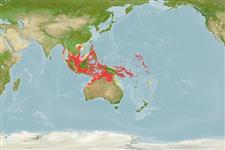Klassifizierung / Names
Namen | Synonyme | Catalog of Fishes(Gattung, Arten) | ITIS | CoL | WoRMS | Cloffa
>
Eupercaria/misc (Various families in series Eupercaria) >
Lutjanidae (Snappers) > Lutjaninae
Etymology: Lutjanus: Malay, ikan lutjan, name of a fish.
More on authors: Quoy & Gaimard.
Environment: milieu / climate zone / Tiefenbereich / distribution range
Ökologie
seewasser riff-verbunden; tiefenbereich 20 - 150 m (Ref. 90102). Tropical; 21°N - 20°S, 92°E - 177°W (Ref. 55)
Western Pacific: Iriomote Island, Okinawa Prefecture, Japan; Fiji to Malay Peninsula. Also recorded from the Andaman Sea off Thailand. This species has been frequently confused with other red snappers, particularly Lutjanus malabaricus.
Size / Gewicht / Alter
Geschlechtsreife: Lm ? range ? - ? cm
Max length : 73.7 cm FL Männchen/unbestimmt; (Ref. 125599); common length : 30.0 cm TL Männchen/unbestimmt; (Ref. 55); max. veröff. Gewicht: 6.7 kg (Ref. 125599)
Rückenflossenstacheln (insgesamt) : 11; Rückenflossenweichstrahlen (insgesamt) : 14 - 15; Afterflossenstacheln: 3; Afterflossenweichstrahlen: 8. Dorsal profile of head steeply sloped. Preorbital width greater than eye diameter. Preopercular notch and knob poorly developed. Scale rows on back rising obliquely above lateral line. Axil of pectoral fin black. Young with a blackish or brownish band from upper jaw to the beginning of dorsal fin and a black saddle preceded by a pearly-white border on upper edge of caudal peduncle; horizontal stripes on sides (Ref. 469). Body depth 2.2-2.4 in SL (Ref. 90102).
Body shape (shape guide): fusiform / normal; Cross section: oval.
Adults inhabit coral and rubble reefs. Usually solitary. Juveniles on muddy coastal slopes on open substrates with small outcrops of reef debris, usually in depth of 15 m or more (Ref. 48635). Relatively uncommon (Ref. 9710).
Life cycle and mating behavior
Geschlechtsreife | Fortpflanzung | Ablaichen | Eier | Fecundity | Larven
Allen, G.R., 1985. FAO Species Catalogue. Vol. 6. Snappers of the world. An annotated and illustrated catalogue of lutjanid species known to date. FAO Fish. Synop. 125(6):208 p. Rome: FAO. (Ref. 55)
IUCN Rote Liste Status (Ref. 130435: Version 2025-1)
Bedrohung für Menschen
Harmless
Nutzung durch Menschen
Fischereien: weniger kommerziell
Tools
Zusatzinformationen
Download XML
Internet Quellen
Estimates based on models
Preferred temperature (Ref.
123201): 23.9 - 28.4, mean 27.3 °C (based on 578 cells).
Phylogenetic diversity index (Ref.
82804): PD
50 = 0.5000 [Uniqueness, from 0.5 = low to 2.0 = high].
Bayesian length-weight: a=0.01413 (0.00864 - 0.02310), b=3.04 (2.91 - 3.17), in cm total length, based on LWR estimates for this species & Genus-body shape (Ref.
93245).
Trophic level (Ref.
69278): 4.0 ±0.66 se; based on food items.
Generation time: 12.8 ( na - na) years. Estimated as median ln(3)/K based on 2
growth studies.
Widerstandsfähigkeit (Ref.
120179): niedrig, Verdopplung der Population dauert 4,5 - 14 Jahre. (Preliminary K or Fecundity.).
Fishing Vulnerability (Ref.
59153): Moderate vulnerability (39 of 100).
🛈
Nutrients (Ref.
124155): Calcium = 30.4 [20.0, 42.1] mg/100g; Iron = 0.314 [0.208, 0.470] mg/100g; Protein = 18.5 [17.0, 19.8] %; Omega3 = 0.144 [0.105, 0.190] g/100g; Selenium = 71.4 [50.2, 98.6] μg/100g; VitaminA = 146 [28, 515] μg/100g; Zinc = 0.424 [0.352, 0.573] mg/100g (wet weight);
